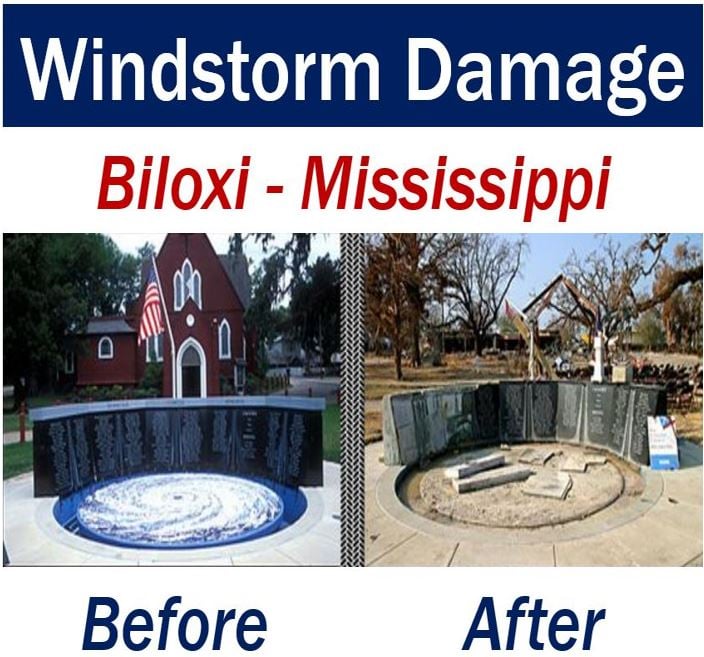A windstorm is a wind that can cause at least light damage to trees and buildings, typically exceeds 34 mph (55 km/h), and may or may not be accompanied by rain. When there is rain, it is light.
Windstorm damage is usually due to short bursts of high-speed winds – gusts – or long periods of sustained wind.
In some countries, tropical cyclones, hurricanes, and tornadoes are not included in the windstorm category. Even though they also produce wind damage, they are sometimes classified separately.
The effects of windstorms are usually included in basic property insurance policies. However, it may be excluded from basic policies in areas where this type of damage is common.
What is windstorm insurance?
Windstorm insurance covers property that is damaged following strong winds. The term may have different meanings, depending on where you are. In all cases, however, it refers to property and casualty insurance. Casualty insurance is a broad term not directly concerned with health insurance, property insurance, or life insurance.
 This before-and-after image clearly shows the type of windstorm damage caused by Hurricane Katrina (2005) in the city of Biloxi, Mississippi. (Image: uk.pinterest.com)
This before-and-after image clearly shows the type of windstorm damage caused by Hurricane Katrina (2005) in the city of Biloxi, Mississippi. (Image: uk.pinterest.com)
Windstorm insurance is available for properties, cars, and commercial buildings and equipment.
In the United States, this type of insurance generally refers to coverage from hail, tornadoes and hurricanes. In Europe, it may refer to damage from winter storm ice and snow, flooding, and hail.
In Asia, it generally means protection from damage caused by typhoons and tsunamis. Wherever you are in the world, check your insurance policy carefully to determine whether it includes damage from wind.
What is derecho?
A windstorm can last anything from a few minutes to several hours or even days. One that travels in a straight line caused by the gust front of an approaching thunderstorm is known as a derecho (Spanish for ‘straight’).
Gustavus Hinrichs, a University of Iowa physics professor, and founder of the Iowa Weather Service, coined the term derecho in 1888 for winds that travel in a straight line.
“Derechos are capable of causing widespread damage and landscape devastation. For example, the winds of a derecho occurring in northern Minnesota, U.S., on July 4, 1999, peaked at or near 160 km (100 miles) per hour and blew down tens of millions of trees.”
What is a European windstorm?
A European windstorm is a severe cyclonic storm, typically when atmospheric pressure is low. It tracks across northwestern Europe and the North Atlantic, usually during the winter months.
Often, deep low pressure areas that travel across the northern parts of the British Isles onto the Norwegian Sea begin as nor’easters off the coast of New England. When they turn southwards, any country in Europe may be affected.
The most commonly-affected regions include the United Kingdom, the Republic of Ireland, Iceland, Norway, and the Faroe Islands.
According to EuropeanWindstorms.wikia.com:
“These storms cause economic damage of €1.9 billion per year, and insurance losses of €1.4 billion per year (1990–1998). They rank as the second highest cause of global natural catastrophe insurance loss (after U.S. hurricanes).”
In a study published in Natural Hazards and Earth Systems Sciences, researchers from the University of Exeter and the Met Office Hadley Centre, both in England, reported that since the turn of the century, the amount that insurance companies have had to pay out for damage caused by windstorms has been declining.
Famous European windstorms
– 1362, Grote Mandrenke: a southwesterly Atlantic gale that swept across southern Denmark, England, northern Germany, and the Netherlands. It killed more that 25,000 people and transformed the Dutch-German-Danish coastline.
– 1634, Burchardi Flood: hit Nordfriesland (northern Germany) and killed between 8,000 and 15,000 people. The island of Strand was destroyed. Some people called it the ‘Second Grote Manderenke’.
– The Great Storm of 1703: the south coast of England was hit by a series of severe gales.
– 1839, Night of the Big Wind: Ireland’s most severe storm. Between 250 and 300 people were killed and thousands of homes destroyed.
– 1859, Royal Charter Storm: the most severe storm to hit Britain in the 19th century. Approximately 800 people lost their lives.
– 1879, Tay Bridge Disaster: Force 10-11 gales swept the east coast of Scotland. The Tay Rail Bridge collapsed and 75 people who were aboard the ill-fated train died.
– 1928, Thames Flood: heavy rainfall combined with snow melt plus a storm surge in the North Sea led to flooding in the center of London. At least fourteen people lost their lives.
– 1953, North Sea Flood: considered to be the worst natural disaster of the 20th century in the United Kingdom and the Netherlands. Approximately 2,500 people lost their lives.
– Gale of January 1976: wind damage was reported across Europe. Germany, Belgium and the UK reported severe coastal flooding. The German North Sea coast had the highest storm surge of the 20th century.
– Great Storm of 1987: southeastern England and northern France were hit by hurricane-force winds. Wind speeds of 70 knots lasting more than ten minutes were recorded in England. There were gusts of 117 knots (217 km/h) in Brittany, northern France. A total of nineteen people perished in England and four in France. More than 15,000,000 trees in England were uprooted.
– 1990 Storm Series: from January 25th to March 1st, eight severe storms crossed the European continent. Insurance companies had to pay out nearly €13 billion.
– 2013-2014, Atlantic Winter Storms: there was a ‘conveyor belt’ series of storms with heavy rainfall and severe flooding in many parts of the United Kingdom.
Video – Windstorm insurance
In this Texas Department of Insurance video, an insurance inspector explains what windstorm insurance is.
